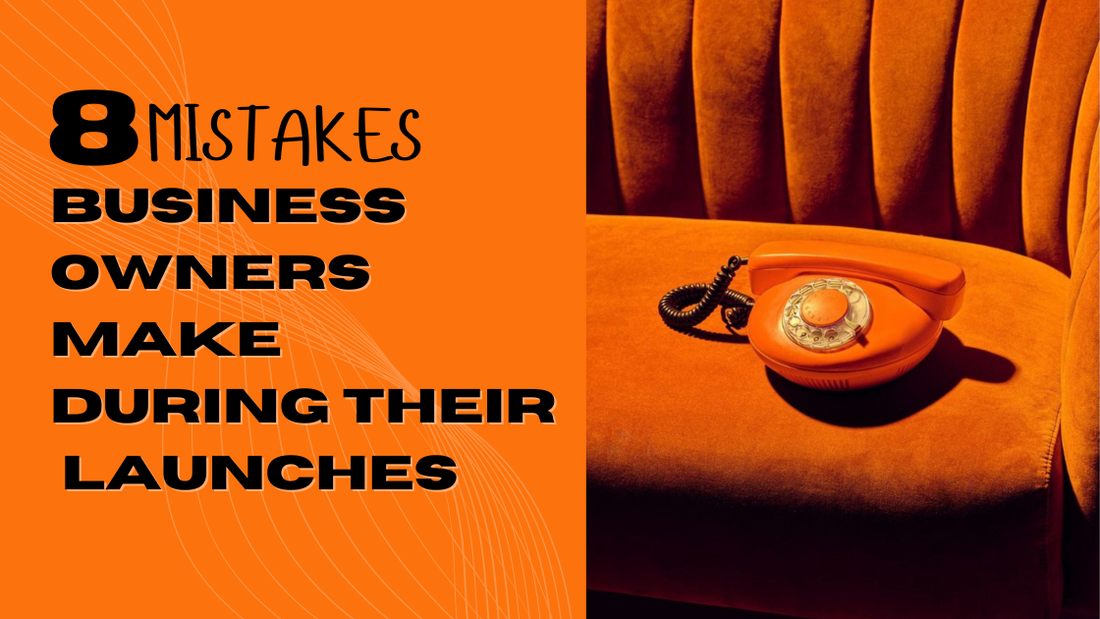Hey there, fellow entrepreneurs! Launching a new product or service can feel like riding a rollercoaster—exciting, nerve-wracking, and full of ups and downs. But here’s the thing: just because it’s a wild ride doesn’t mean it has to be a chaotic one. After helping countless businesses navigate their launches, I’ve seen the same mistakes crop up time and time again. So, let’s talk about the eight most common launch mistakes—and more importantly, how you can avoid them.
Launch Mistakes
1. Not Setting a Goal for the Launch
You wouldn’t set out on a road trip without knowing your destination, right? The same goes for your launch. Without clear, measurable goals, you’re driving blind. Goals give you direction and something to measure your success against.
Proof it matters: According to a study by CoSchedule, marketers who set goals are 376% more likely to report success. Check it out here.
How to fix it: Before you do anything else, set SMART goals—Specific, Measurable, Achievable, Relevant, and Time-bound. Maybe it’s a certain number of sales, email sign-ups, or just getting your name out there. Whatever it is, write it down and keep it front and center.
2. Not Using Market Research to Create Pain Points
Your audience doesn’t care about your product—sorry, but it’s true. They care about how your product solves their problems. If you’re not tapping into those pain points, your launch messaging is going to miss the mark.
Proof it matters: Research by CB Insights shows that 42% of startups fail because there’s no market need for their product. Read more here.
How to fix it: Dive into market research to really understand your audience. Surveys, interviews, social media listening—whatever it takes to get inside their heads. Then, use what you find to craft messaging that speaks directly to their needs.
3. Not Allowing Enough Time to Build Hype
If you’re launching something amazing but nobody knows about it, does it even matter? Not really. Too many business owners rush their launches, missing the opportunity to build anticipation and excitement. Don't make this launch mistakes.
Proof it matters: A study by Harvard Business School found that companies that built anticipation before launch saw significantly higher sales and customer engagement. Explore the findings .
How to fix it: Give yourself at least a few weeks (ideally six) to build hype. Start dropping hints, sharing sneak peeks, and getting people excited about what’s coming. You can read my full guide on this here

4. Not Talking About It Enough
I get it—self-promotion can feel awkward. But if you’re not talking about your launch, nobody else will. You’ve got to be your own biggest cheerleader, and that means getting the word out there.
Proof it matters: Research from Sprout Social found that 85% of consumers need to see a product multiple times before they buy. Dive into the data.
How to fix it: Create a content calendar and plan out how you’re going to talk about your launch across all your platforms—social media, email, your website, etc. And don’t be afraid to repeat yourself—people need to hear it more than once.
5. Not Creating FOMO with a Waitlist
Scarcity and exclusivity are powerful motivators. When people think they might miss out on something, they’re more likely to take action. But if you don’t give them a reason to feel that urgency, they’ll just scroll on by.
Proof it matters: A study published in the Journal of Consumer Research found that scarcity can significantly boost demand. Check out the study.
How to fix it: Create a waitlist before your launch and start promoting it early. Offer exclusive perks to those who sign up—early access, special discounts, you name it. Make it clear that this is their chance to be the first in line.
6. Focusing Too Much on the "What" and Not the "Why"
It’s easy to get caught up in the details of your product—what it does, how it works, all the cool features. But here’s the thing: people don’t buy what you do, they buy why you do it. They want to know how your product will change their lives.
Proof it matters: Simon Sinek’s "Start With Why" framework has shown that companies who focus on their "why" can build stronger connections with their customers. Watch his TED Talk.
How to fix it: When you’re crafting your launch messaging, don’t just talk about the features—talk about the benefits and the bigger impact. What problem does your product solve? How will it make your customers’ lives better? Lead with that.
Ready to learn a fool proof 6 week launch strategy to sell out on your next launch? I'm creating an epic interactive guide - giving you the blueprint that caused me to take over £12,000 on my last launch.
7. Forgetting the Importance of Post-Launch
The launch isn’t the finish line—it’s just the beginning. But too many business owners put all their energy into the launch and forget about what comes next. If you don’t have a plan for maintaining momentum, your hard work could fizzle out fast.
Proof it matters: Research by McKinsey & Company shows that businesses that engage with customers post-launch see higher retention and customer lifetime value. Read the full report.
How to fix it: Plan out your post-launch strategy before the big day. Think about how you’re going to keep the conversation going, follow up with customers, and keep driving sales. This could be through email campaigns, social media, or even a follow-up event.
8. Not Reflecting on the Launch to Learn for the Next One
If you’re not learning from your launch, you’re missing out on valuable insights that could make your next one even better. Too often, business owners move on to the next thing without taking the time to reflect.
Proof it matters: According to Harvard Business Review, companies that conduct post-mortem analyses of their projects are more likely to achieve their future goals. Learn more here .
How to fix it: After your launch, take some time to analyze what worked and what didn’t. Look at your metrics, gather feedback, and document your learnings. Use this to improve your strategy for the next launch.
Launching something new is a big deal, and it’s totally normal to hit a few bumps along the way. But by avoiding these common mistakes, you can set yourself up for a launch that’s not just successful, but also stress-free. Remember, it’s all about planning, execution, and learning as you go. You’ve got this!



